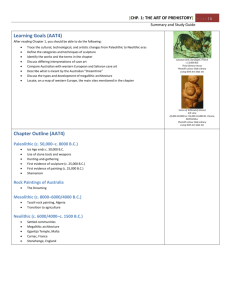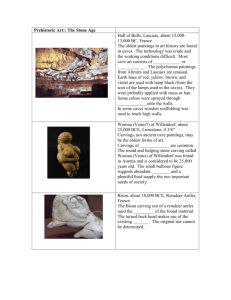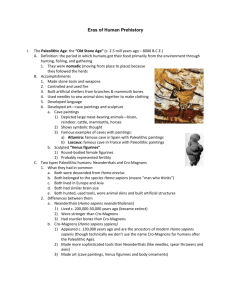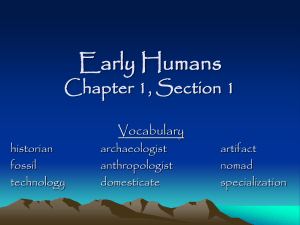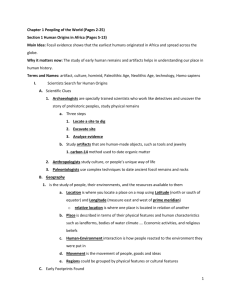Chp. 1: The ARt of Prehistory
advertisement
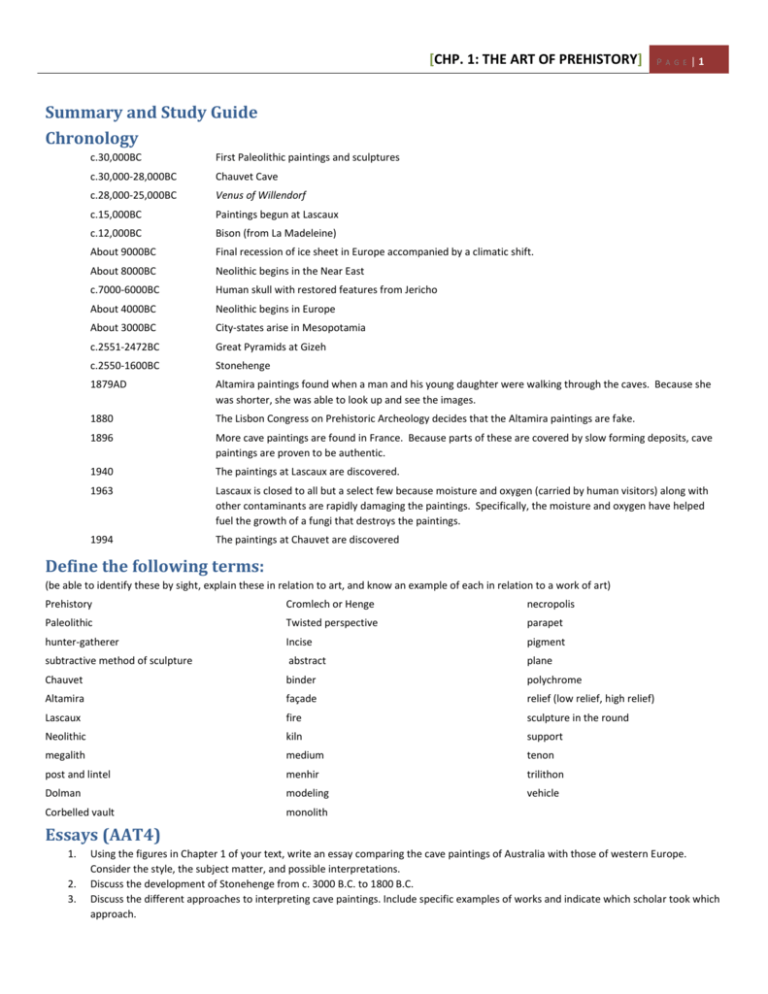
[CHP. 1: THE ART OF PREHISTORY] P A G E |1 Summary and Study Guide Chronology c.30,000BC First Paleolithic paintings and sculptures c.30,000-28,000BC Chauvet Cave c.28,000-25,000BC Venus of Willendorf c.15,000BC Paintings begun at Lascaux c.12,000BC Bison (from La Madeleine) About 9000BC Final recession of ice sheet in Europe accompanied by a climatic shift. About 8000BC Neolithic begins in the Near East c.7000-6000BC Human skull with restored features from Jericho About 4000BC Neolithic begins in Europe About 3000BC City-states arise in Mesopotamia c.2551-2472BC Great Pyramids at Gizeh c.2550-1600BC Stonehenge 1879AD Altamira paintings found when a man and his young daughter were walking through the caves. Because she was shorter, she was able to look up and see the images. 1880 The Lisbon Congress on Prehistoric Archeology decides that the Altamira paintings are fake. 1896 More cave paintings are found in France. Because parts of these are covered by slow forming deposits, cave paintings are proven to be authentic. 1940 The paintings at Lascaux are discovered. 1963 Lascaux is closed to all but a select few because moisture and oxygen (carried by human visitors) along with other contaminants are rapidly damaging the paintings. Specifically, the moisture and oxygen have helped fuel the growth of a fungi that destroys the paintings. 1994 The paintings at Chauvet are discovered Define the following terms: (be able to identify these by sight, explain these in relation to art, and know an example of each in relation to a work of art) Prehistory Cromlech or Henge necropolis Paleolithic Twisted perspective parapet hunter-gatherer Incise pigment subtractive method of sculpture abstract plane Chauvet binder polychrome Altamira façade relief (low relief, high relief) Lascaux fire sculpture in the round Neolithic kiln support megalith medium tenon post and lintel menhir trilithon Dolman modeling vehicle Corbelled vault monolith Essays (AAT4) 1. 2. 3. Using the figures in Chapter 1 of your text, write an essay comparing the cave paintings of Australia with those of western Europe. Consider the style, the subject matter, and possible interpretations. Discuss the development of Stonehenge from c. 3000 B.C. to 1800 B.C. Discuss the different approaches to interpreting cave paintings. Include specific examples of works and indicate which scholar took which approach. [CHP. 1: THE ART OF PREHISTORY] 4. 5. 6. P A G E |2 Describe the cultural and artistic changes from Paleolithic to Neolithic. Include dates, styles of living and working, painting, sculpture, and architecture. If you were a Paleolithic boy or girl of about 15, how do you imagine your average day from the time you wake up in the morning to the time you go to sleep at night? Discuss the interpretations of prehistoric female figures, such as the Venus of Willendorf and the Venus of Laussel. Identify (know these works by sight, title, date, medium, scale, and location (original location also if moved) and be able to explain and analyze these in relation to any concept, term, element, or principle) Paleolithic “Venus of Willendorf,” from Willendorf, Austria, c.28,000-25,000BC, limestone Bison, from La Madeleine, Dordogne, France, c.12,000BC, reindeer horn Neolithic Human skull with restored features, from Jericho, c.7,000-6,000BC Stonehenge, Salisbury Plain, Wiltshire England, c.2550-1600BC Study Questions 1. List two caves that contain Paleolithic paintings: 2. What were the functions of Paleolithic art (monumental paintings and sculpture)? 3. The figurine known as the Venus of Willendorf was probably used originally as: 4. What new type of subject matter became important in the Mesolithic rock-shelter paintings? 5. Why was Stonehenge thought to have erected? What evidence supports this belief? 6. Archeological findings indicate that civilization did not originate in the Nile River valley of Egypt, as was earlier believed, but developed in grassy uplands in settlements like Jericho, located in ____________________________ and dating from the ___________ millennium B.C. and Catal Huyuk, located in _______________ , which is modern day __________________. 7. Describe the unique structure erected in Jericho. 8. Describe the peculiarity of Catal Huyuk and the materials and system of building houses and shrines. 9. When was Stonehenge thought to have been erected? What do archeologists generally consider Stonehenge’s original purpose to have been? What evidence supports this belief? 10. Discuss the materials and techniques used by Paleolithic artists to create images of animals. How might the materials have influenced the representations? 11. What do you think the purpose of the early female figures like the Venus of Willendorf might have been? Why do you think that Paleolithic artists depicted women more often than men? 12. In what way did the social and economic changes that took place in human development between the Paleolithic and Neolithic periods affect the art produced in each period?
